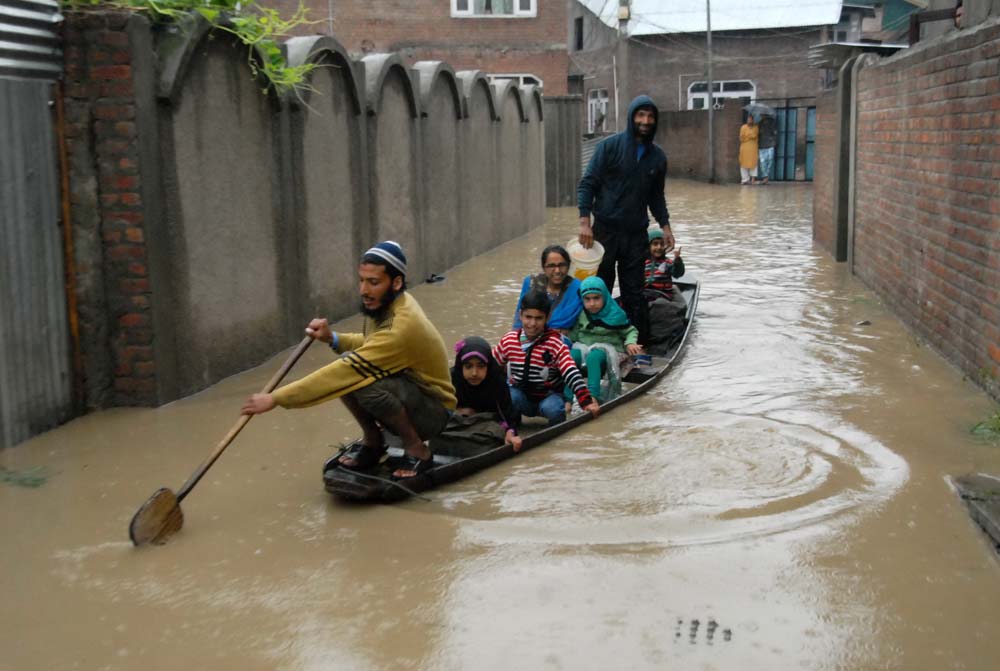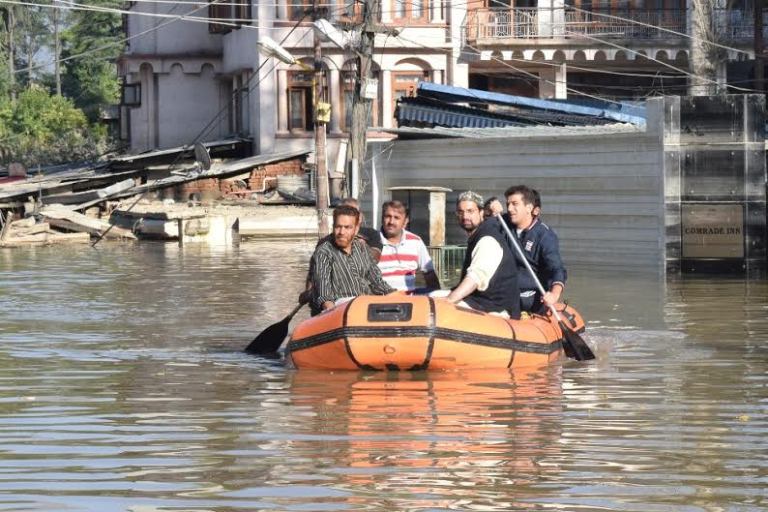Encircled from three sides by swelling Jhelum, people living in Srinagar’s posh locality Rajbagh had only downtown boys standing between life and death. Political Editor Kashmir Life Shah Abbas survived miraculously to tell his story

Two weeks have passed but the images of 7th September 2014 are still afresh in my mind. It still haunts me how I managed to walk through neck-deep water and make my way out of the Rajbagh using the already submerged Abdullah Bridge. It was like living through a horror movie. There were scenes of helplessness and desperation all around as Jhelum had breached from three side: Gadehenzpora, Kursoo and Abdullah Bridge, trapping people inside their houses.
It [water] came so quickly that people could barely manage to save their lives. But not all were fortunate. Like many others, I along with my family was waiting for any official assistance till the last hour, but all in vain. It was around midnight when people of Rajbagh actually gauged Jhelum’s mood and started leaving their houses. I was probably among the last lot who left at 3:10 AM along with my ten-year-old son and wife. It was kind of reverse migration as most of the people started running towards old-city, a place they had left in order to live in posh Rajbagh.
The people living in the areas falling under Nawhatta, Maharaj Gunj, Khanyar, Zadibal, Safakadal and Shaheed Gunj police stations had to arrange lunch for more than ten thousand displaced people.
The people falling under the said areas often face curfews and restrictions because according to police and civil administration they are most volatile and these areas witness stone pelting, shutdowns and anti-India protests.
But today those living in the posh areas like Rajbagh, Jawahar Nagar, Radio Colony and Bemina areas of the city had relied on the “miscreants” of the old city who did not disappoint their brethren and left not a single soul hungry by their war-footing efforts at a time when the administration was found snoozing and people were weeping and wailing for their property and nears and dears.
The residents near the Gadehenzpora had smelled the danger earlier, however, the people of Kursoo were unaware about the situation so they waited and waited till midnight when somebody informed them about the breach from the Gadehenzpora side and they got scared.
Had people been informed by the authorities about the river breach a bit earlier, the number of people trapped in the area would have been very low.
The locals took the announcements made from the Mosques casually because of their ambiguity. “Who was making those announcements and on whose behalf, we still do not know,” said one Nazir Ahmad, adding, “If the announcements were official they should have informed us about the amount of water coming towards us and the breach in the river so that we could have taken preventive majors like fleeing the area much earlier.”
The Sunday sun witnessed the brave youth of the old city running towards the flood-hit areas of the civil lines and Chattabal with whatever sources they had. Not fearing for their lives, the local youth saved thousands of precious lives by reaching the helpless people trapped in as high as fifteen feet of water. It was the time when the administration was indecisive about the situation. The day passed witnessing the bravery of Kashmiri youth but the situation became grim as the young rescuers informed about the huge numbers of people trapped in the floods. The elders took the information very seriously and they decided to act swiftly.

“Those who believe in Allah and His great messenger prophet Mohammad (SAW) cannot sleep in their houses when thousands of humans are in distress and waiting for help,” an announcement made from a local mosque in Zadibal at around 10:30 PM alerted the locals. It added: “The youth up to the age of 30 years are duty-bound to leave and help the people whose lives are at stake.” Such announcements from the local mosques were enough to assess the situation of the flood-hit areas.
Credit goes to these youngsters who evacuated all patients from SMHS and Lal Ded hospitals by putting their own lives in danger. These youth had reached from far off places as well to help victims. Two such youth from Bandipora who had reached with their own boat saved the lives of two kids in the Nawab Bazar area.
The father of two minors (an employee in fire and emergency services) was on duty; while as, their mother was out for some work when their residence got submerged. The young heroes from Bandipora rescued the kids in a shocking state. Their overjoyed parents tried to reward the rescuers, but they refused, saying, “We have come to help our brothers not to earn from them.”
By the time, the relief had started coming from all areas of the valley. Most of those who were sending the relief were themselves badly hit by the massive flood. The relief material was received at various lungers and camps. The youngsters were taking eatables for the people stranded at Rajbagh and Jawahar Nagar people from as far as Habbakadal and Hyderpora. A youth who identified himself as Ashraf stopped at the bund near submerged Sadar Court’s building and said pointing towards the complex: “Police had charge-sheeted me and my two other friends in two fake cases. And these judges were not paying any heed to my innocence. Now see, Judge of judges has given His verdict!”

Army too had started its “selective” rescue operation in the area. People were watching choppers flying over the city after every five minutes. At the Rajbagh Gath, some six to eight personnel of JAKLI had surrendered their two boats and a sound system to local youth and the army men were busy discussing “flood politics” on the Jhelum bund. The situation was quite contrary at Rajbagh crossing near Modern Hospital where an army boat was driven by two army personnel and an officer yielding a Kalashnikov was asking locals to lead them to the trapped people.
Eyewitnesses told this reporter that army personnel had a list already with them and they were only trying to reach those “special” people. They also alleged that helicopters were dropping eatables to “selected” people and areas only. Same allegations were from hundreds of people who had made makeshift residential arrangements along the bund from Lal Mandi to Zero Bridge. “Choppers came twice and dropped a few packets which fell into the Jhelum,” Abdullah Hakak, an elder said, alleging, “it was a deliberate attempt on part of the chopper-bound men.”
An example of the “selective” relief was also witnessed in a downtown area where a Casper vehicle of the army was distributing drinking water among the victims. When a local approached the vehicle and pleaded for a bottle of water for his thirsty child, the army men surprised everybody by refusing him, saying: “It is meant for the tourists only!” The attitude of the army resulted in some protests at many places of the city. The tempers soon cooled down after some sensible elders intervened. And the locals again got busy in rescue and relief operations.
On Thursday (September 11), a chopper dropped quintals of eatables and medicine for the people stranded in the Sharika Devi temple situated at Koh-e-Maran hillock. It took the same helicopter a few seconds to reach the other side of the fort where thousands of people had taken shelter in the Makhdoom Sahab Shrine and its mosque. The chopper dropped only twelve pockets of grinded rice locally called Sattu and “expired” bread. This infuriated the people who threw footwears towards the flying machine in rage.
No doubt, army personnel saved many precious lives during their rescue operation and their choppers kept the hopes of trapped people alive. But it was not any extraordinary effort as expected from an institution like an army. Many analysts are of the opinion that a campaign was started by the electronic media which was aimed at glorifying army in the most militarized region of the word. And all this was done at the cost of professional ethics. “That is why, a camera remained always ready, as and when, anybody was being rescued or food packets were being dropped,” Tariq Ali Mir, a Srinagar based journalist, said.

But people were all around praising Separatists like Syed Ali Geelani, Mirwaiz Umar Farooq, Mohammad Yasin Malik, Shabir Ahmad Shah, Nayeem Ahmad Khan, Zafar Akbar Bhat and the volunteers of Jama’at-e-Islami, Islami Jamiat-e-Tulba and many journalists who had organised lungers and relief camps to reach out to the flood victims. Otherwise, the situation would have been worse than it is now.
I spent a week’s time at Zadibal and used to travel the areas of the old city almost on a daily basis. What I found was that youth had taken charge of everything and the elders were busy making arrangements in temporary lungers and camps. However, the police were missing. In their absence, the locals were managing traffic at various junctures, making ways for the sick and injured people. “What administration did, was, it ended long house detention of Geelani Sahab immediately after the flood,” said Mohammad Yasin Khanday of Nawab Bazar. “Perhaps the authorities knew Geelani along with other separatists has the capacity to reach out to the affected people.”
Note: Story may not be the reflection of the entire flood situation in Kashmir as the author had limited access and resources.















